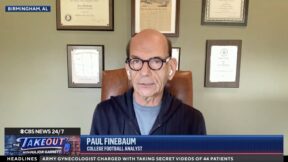Wolf Blitzer Puts President Calderón On The Defensive Over Mexico’s Immigration Laws
 After appearing before Congress and attacking Arizona’s new illegal immigration law, Mexican president Felipe Calderón appeared on CNN to talk shop with Wolf Blitzer. Blitzer, rather surprisingly, turned the tables on the president, opting to ask him instead about his country’s immigration laws, and whether they were just as strict (if not stricter) than Arizona’s. Calderón admitted that laws were stringent in the past but clarified that it is currently not illegal to be undocumented in Mexico.
After appearing before Congress and attacking Arizona’s new illegal immigration law, Mexican president Felipe Calderón appeared on CNN to talk shop with Wolf Blitzer. Blitzer, rather surprisingly, turned the tables on the president, opting to ask him instead about his country’s immigration laws, and whether they were just as strict (if not stricter) than Arizona’s. Calderón admitted that laws were stringent in the past but clarified that it is currently not illegal to be undocumented in Mexico.
Citing a Washington Times article explaining Mexican immigration laws that incriminated those who willfully participated in illegal immigration or helped illegal immigrants, Blitzer asked President Calderón to contrast those laws with Arizona’s. Calderón replied that, while the Times assessment used to be true, it is no longer, and immigration cannot be illegal in Mexico. “Of course, on the border, we are asking people ‘Who are you?'” explained Calderón, and “Once they are inside the country, what the Mexican police do is, of course, enforce the law, but any means immigration is a crime anymore in Mexico… if someone does that, we find them and sending [sic] them back.”
In response to that, Blitzer noted that many in the US do not know that Mexico does not criminalize illegal immigration, and reference the older, harsher laws to argue that border states are only trying to do what Mexico does in its lower half, as well. Calderón accepted the criticism, and said he took it into account when discussing immigration laws:
That is a very powerful argument, but that is one of the reasons why we are trying to change our policies. And let me be frank, Wolf. In the past, Mexican authorities were, in an unfortunate way, in the treatment for immigrants. But we are changing the policies, we changed already the law, and that is different today. We are trying to write a new story, talking about immigrants, especially coming from Central American countries.
The interview segment below:
>




